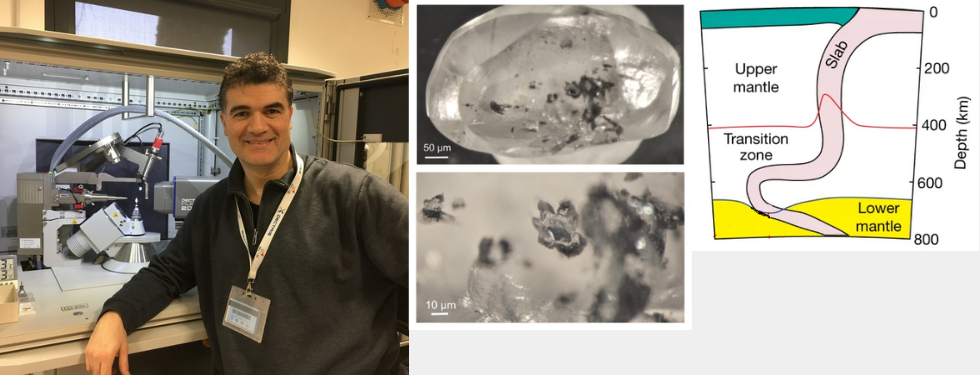Superdeep diamonds: a new study sheds light on the Earth’s interior

Superdeep diamonds, which originate from depths of more than 300 kilometres below Earth’s surface, are a sort of time capsules of scientific information because as chemically inert vessels, diamonds can envelop real fragments of minerals and, amazingly, protect them from chemical modifications with their surroundings when they are brought to the Earth's surface. In this way diamonds are able to preserve information about where they’re formed, including many of the physical and chemical processes that occurred during their formation.
A unique combination of minerals trapped inside a superdeep diamond, analyzed by an international study recently published in Nature, sheds new light on the composition of the Earth’s mantle and deepens our understanding of plate tectonics.
The study, led by Fabrizio Nestola, Full Professor at the Department of Geosciences of the University of Padova, describes the chemical composition of a truly unique and sensational diamond from Kankan, Guinea.

Photo A - Microphotograph of the diamond studied - photo by Margo Regier
The inclusions enclosed in this superdeep diamond (Photo A) reveal a complex sequence of chemical reactions occurred during the process of subduction, when the slabs descended into the mantle.
The subduction process is one of the main phenomena geology at the base of the plate tectonics on our planet, the theory that indicates that the lithosphere, the solid, outer part of Earth, is divided into about twenty rigid portions, called plates.

Photo B - Microphotograph of the studied diamond showing the inclusions trapped within it - photo by Margo Regier
The suite of inclusions analyzed (Photo b) provides powerful insights into the complex sequence of oxidation/reduction reactions that occur in proximity to deeply subducted slabs of oceanic lithosphere. More in detail, the discovery of pure forsterite, at present unique for an olivine inclusion in diamond, and the chemical reactions that took place inside the diamond indicate and confirm the presence of water at very great depths (about 660 km), in conjunction with methane (CH4) and molecular hydrogen (H2). The olivine’s purity, as well as some of the other minerals that were inclusions in this diamond, indicate a far deeper origin than usual for a diamond. It also shows that the environment between these zones has an extremely variable oxygen content.
At the same time, the discovery empirically confirms for the first time what had only been simulated in geophysics by very complex calculations: the tectonic plates sometimes penetrate the mantle following non-linear paths.
“It cannot be excluded that such paths could be an additional complexity for seismologists considering the development of some extremely deep earthquakes sometimes reaching magnitude 7 and occurring at depths greater than 600 km”, Prof. Fabrizio Nestola said.
Figure C - Subducting plate moving non-linearly reaching the lower mantle. Figure modified from Fabrizio Nestola et al. 2023
“The scientific literature believes that these earthquakes are related to subducting plates and our article supports this hypothesis by making the scenario even more complex, as shown in Figure c, not only with a non-linear plate trend – which it moves to great depths – but causing a sequence of hydration and dehydration of the rocks that are entering the lower mantle”, Prof. Nestola added.
“The presence of water at great depths in the Earth had already been discovered in 2014 thanks to another super deep diamond, however with this new study we not only confirm that water must absolutely be present between the transition zone and the lower mantle, but that at those depths we must also have other fluids such as methane and molecular hydrogen”, said Luca Bindi, Full Professor at the Department of Earth Sciences of the University of Florence and co-author of the study.
“The process of subduction is fundamental to plate tectonics on Earth. In addition to driving plate movement, this process imposes some of the strongest gradients in oxygen activity in Earth’s convecting mantle. Understanding how these gradients form and their magnitude can provide clues to the formation of Earth’s largest and most valuable diamonds in addition to allowing a clearer understanding of how plate tectonics cycles volatile elements back into the mantle from the hydrosphere and crust”, ended Chiara Anzolini, researcher at the University of Alberta who participated in the study together with the colleagues Graham Pearson, Margo Regier, Robert Luth and Thomas Stachel.
Press information
Article title: Extreme redox variations in a superdeep diamond from a subducted slab" - «Nature» - 2023.
LINK: https://www.nature.com/articles/s41586- 022-05392-8
Authors: Fabrizio Nestola, Margo E. Regier, Robert W. Luth, D. Graham Pearson, Thomas Stachel, Catherine McCammon, Michelle D. Wenz, Steven D. Jacobsen, Chiara Anzolini, Luca Bindi & Jeffrey W. Harris





